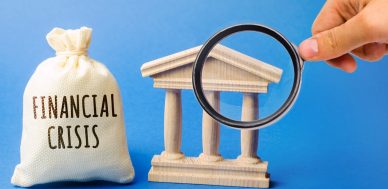Volatility in Interest Rates Sets Stage for Financial Crisis
If you listen to the Federal Reserve and the mainstream financial press, you might be convinced that everything is under control in the stock market and the economy. Sadly, here’s the reality: the odds of a financial crisis happening in the next 12 to 18 months could be at their highest level since the financial crisis of 2008–2009.
A financial crisis is when asset prices plunge, the financial system becomes severely stressed, and panic prevails. Investors beware: massive losses could be ahead.
There’s one major factor investors need to really look at: volatility in the interest rate market.
See the chart below; it plots the yield of 10-year U.S. Treasury bonds. This yield is a benchmark interest rate for many things, including mortgages, car loans, and how banks lend to each other. If the yield on these bonds moves, interest rates across the board will move.
Chart courtesy of StockCharts.com
Over the past year, the yield on 10-year U.S. treasuries has spiked by nearly 100%. Since the time of the COVID-19 pandemic, the yield on these bonds has increased by close to 170%. In other words, interest rates have been extremely volatile.
The Problem: Too Much Debt
The U.S. economy is extremely leveraged at the moment.
U.S. consumer debt in the first quarter of 2022 grew from $266.0 billion to $15.8 trillion. Consumer debt balances are now $1.7 trillion higher than they were back in 2019—just before the pandemic. (Source: “Household Debt and Credit Report,” Federal Reserve Bank of New York, last accessed June 8, 2022.)
Thanks to low interest rates in the past several years, Corporate America has also become addicted to debt. At the end of 2021, the outstanding corporate bonds in the U.S. stood at a little over $10.0 trillion. At the end of 2019, it was $8.9 trillion. (Source: “US Corporate Bonds: Issuance, Trading Volume, Outstanding,” Securities Industry and Financial Markets Association, last accessed June 8, 2022.)
Moreover, the U.S. government has borrowed money without remorse. The U.S. national debt stands at $30.4 trillion. (Source: “Debt to the Penny,” U.S. Treasury, last accessed June 6, 2022.)
In the coming years, there’s absolutely no budget surplus in sight. This means the national debt could go a lot higher than it is now.
The financial sector has also taken some wild steps. At the end of 2021, it had derivatives with a notional value of $177.5 trillion. Here’s the kicker: 71.1% of those derivatives were tied to interest rate-related products. (Source: “Quarterly Report on Bank Trading and Derivatives Activities: Fourth Quarter 2021,” Office of the Comptroller of the Currency, last accessed June 8, 2022.)
With So Much Debt & So Many Derivatives, Could Something Go Wrong?
Dear reader, I don’t like to be the bearer of bad news. I like it when everyone is making money. However, I don’t like to stick my head in the sand and pretend everything is great when it’s not.
There’s a lot of volatility in the interest rate market and there’s a lot of debt and derivatives tied to interest rates. As such, I think it’s likely that something will go wrong. The dollar amount behind interest rate derivatives is so high that, if just five percent to 10% of the outstanding derivatives move in the wrong direction, we could see a bank collapse in no time.
The financial crisis of 2008–2009 was triggered by a high amount of debt and derivatives. If a new financial crisis becomes a reality, an immense amount of misery could follow.
The market generally bottoms in the midst of a financial crisis at 10 to 15-year lows, not at two to five-year lows. There could be significant losses across various assets, so a lot of caution could be required.
